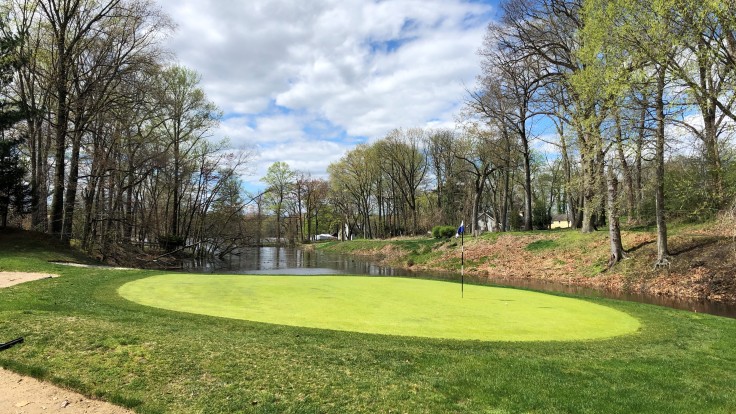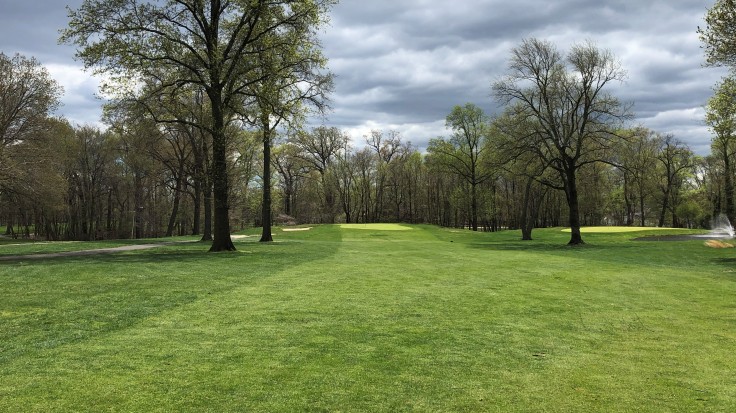As I’ve learned more about golf course architecture, I’ve become fascinated with mid-20th century design. Robert Trent Jones, Sr. was the most influential golf course architect of the post-World War II era up through the 1980s. He was most widely known as the “Open Doctor” for his work altering Golden Age courses to fit the “modern” game with a design philosophy to make “a difficult par.” In the Philadelphia region, Jones designed just one course, a public course called Rancocas Golf Club in Willingboro, NJ.
Rancocas features some very interesting holes, but also includes some duds. The front nine is fairly open but the back is heavily wooded, with many tight tree-lined corridors and dogleg holes. With rates peaking at $59.95 to ride on the weekend, $41.95 on weekdays and $30.95 for twilight, it’s a good value despite some conditioning challenges. The pro shop and grill are modest and the staff was friendly on my visit. It’s a convenient 30-40 minute drive from most parts of the city.

Course History & Architect Profile
Opening in 1966 at the center of a new housing development on the Rancocas creek, the course was designed at the height of Robert Trent Jonesm, Sr.’s powers. Originally a semi-private club called Willingboro Country Club, the club fell on hard times and was purchased around 1990 by American Golf Corp. Since opening, there have not been any significant changes to the course routing or architecture, aside from the addition of paved cart paths.
The Architect
Robert Trent Jones, Sr. attended Cornell with a focus in golf course architecture and began his career in design in the 1930s by partnering with Canadian designer Stanley Thompson. After struggling through the 1930s, Jones’ first big job came shortly after World War II, collaborating with famed amateur golfer Bobby Jones on Peachtree Golf Club in Atlanta. To avoid confusion, he added his middle name “Trent” to help differentiate himself from the golfer. Jones gained national fame by renovating Donald Ross’s Oakland Hills Country Club ahead of the 1951 US Open and became the “Open Doctor” by toughening up courses to host major championships. In total, Jones had a design influence on over 400 golf courses, with his work hosting 20 US Opens and 12 PGA Championships. His original designs include Hazeltine National (2016 Ryder Cup), Spyglass Hill, Bellerive Country Club (2018 PGA), and Firestone Country Club. RTJ passed on the trade to his two sons, Bobby and Rees, who have also had long and distinguished careers.

Jones believed in “A Difficult Par”, the title of his official biography. He had numerous pioneering design philosophies, ushering in “modern” ideas and styles that differentiate his generation from the Golden Age. His “runway” tee boxes could be as long as 100 yards, but were easy to maintain. RTJ courses featured large, undulating greens, protected by bunkers or water, that are more suitable today than when designed due to increased green speeds. Fairways were typically narrow, surrounded by thick rough and pinched by bunkering on one or both sides.
The Takeaway
Overall, I found Rancocas Golf Club to be an enjoyable golf course. Though at the center of a housing development, it was early in the residential golf trend so the homes don’t come into play at all. As a result, it’s still a very pretty and peaceful setting. There is generally a good variety of holes, especially the par 4s and 5s, though the par 3s were all very similar in length and strategy. True to RTJ’s principles, the greens are large and well guarded by bunkers. With narrow fairways, and occasionally narrow playing corridors, par is often a good score but it’s also difficult to get into real trouble.
The front nine is much more interesting than the back. This was partly due to it being more open, but also the holes offered more strategy and variety. On the back, a couple holes were engaging, but it features a couple lackluster holes and much less strategy mostly due to being cramped and heavily wooded. For example, the par-5 13th is a one-route, 3-shotter requiring a long and accurate drive to be able to get back up a hill to the green through a narrow window. For a par-5, it’s a bit tedious and lacks a risk-reward challenge. Both the 14th and 16th feature approaches over a pond to the green. Though different shot shapes off the tee, having the same approach so close together on the course is not ideal. The closing hole is particularly claustrophobic, again providing only one route and penalizing all but the most accurate of drives.

Like the surrounding neighborhood, the golf course shows it’s age and could use some renovation work. Many of the trademark “runway” tee boxes were significantly crowned, though it appears they’ve been working on that issue over the winter. The course features over 90 bunkers, and the few I found my way into had a significant number of rocks, so be sure to take advantage of the new rules regarding loose impediments in traps. I played in mid-April, on a very windy day following significant rain, so I didn’t get a great sense of turf conditions in season. Aerial photos would indicate that the greens are kept in very good condition, while the rest of the course may suffer at times. My experience on the ground backed that up, with the greens rolling very nicely. There’s plenty of room to expand the fairways (currently 15-25 yards wide in most spots) and bring them out to the fairway bunkers. Unfortunately there are a few spots where the cart path was built inside the fairway bunkers, rendering them mostly pointless (the 6th hole is particularly egregious).

 Rancocas is definitely a course I’ll revisit. I’d like to see how it plays in the summer months and on a more crowded day. With nice greens and reasonable greens fees, it’s a pretty good example of RTJ’s work that remains relatively unchanged in the last 50 years. With rebuilt tee boxes, added fairway width and some tree work, it could easily move up in quality and stature.
Rancocas is definitely a course I’ll revisit. I’d like to see how it plays in the summer months and on a more crowded day. With nice greens and reasonable greens fees, it’s a pretty good example of RTJ’s work that remains relatively unchanged in the last 50 years. With rebuilt tee boxes, added fairway width and some tree work, it could easily move up in quality and stature.


Leave a comment